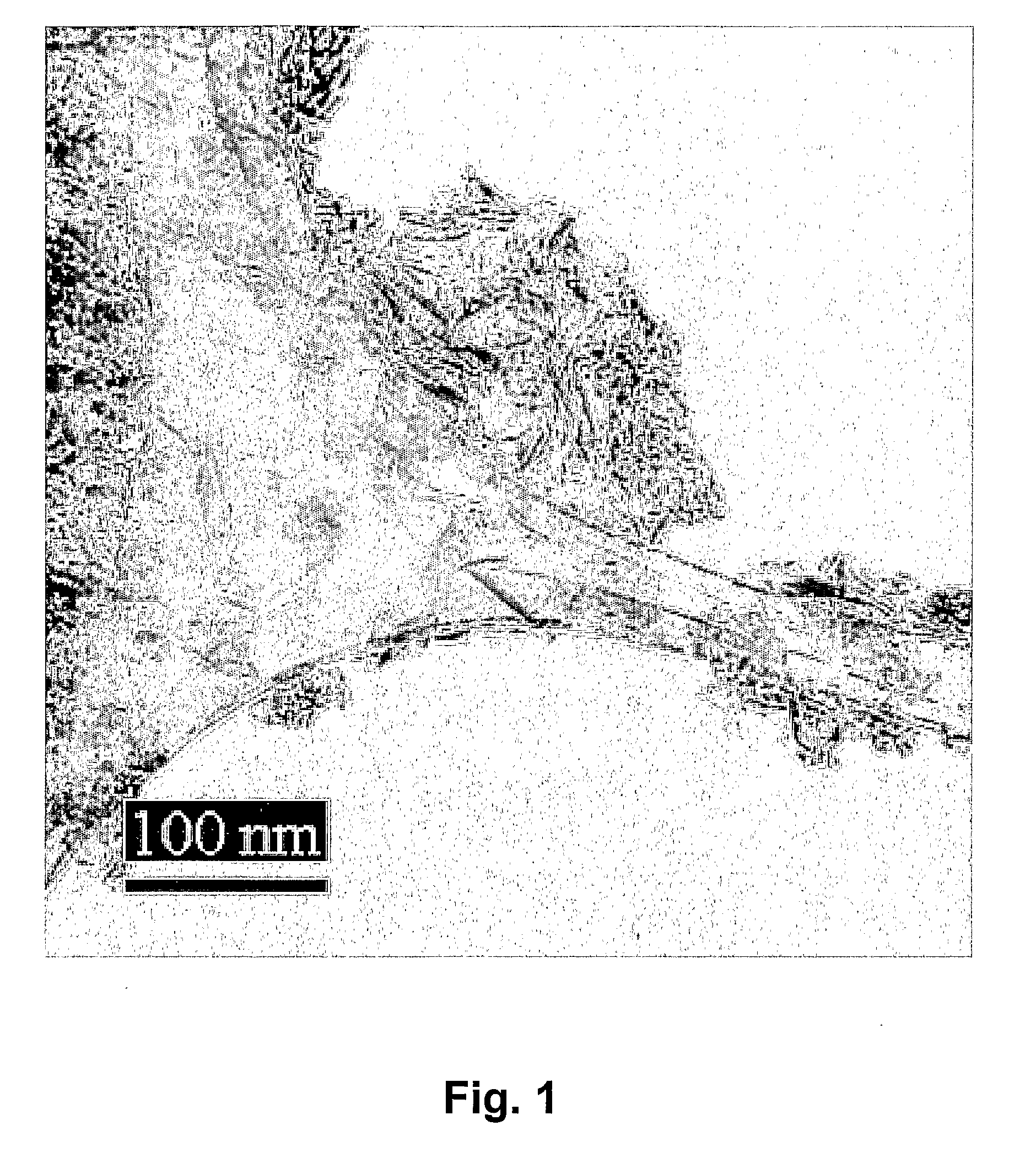Synthetic Nano-Sized Crystalline Calcium Phosphate and Method of Production
a technology of crystalline calcium phosphate and synthetic nano-sized crystalline calcium phosphate, which is applied in the direction of synthetic resin layered products, transportation and packaging, coatings, etc., can solve the problems of low mechanical reliability, inability to carry heavy loads by itself, and the installation detachment, so as to maximize the adhesion to the surface, increase the strength of the material, and facilitate the deposited
- Summary
- Abstract
- Description
- Claims
- Application Information
AI Technical Summary
Benefits of technology
Problems solved by technology
Method used
Image
Examples
example 1
Production of Hydroxyapatite Powder
[0063]The powder is manufactured using a liquid crystalline phase. Such a phase is built-up of surfactants, water and optionally a hydrophobic phase that is an organic solvent. The surfactants that we have used are so-called block co-polymers of the structure PEG-PPG-PEG (block poly(ethylene glycol)-block poly(propylene glycol)-block poly(ethylene glycol)). BASF manufactures this polymer series under the name Pluronic, but the chemical company Aldrich also sells almost identical block co-polymers. We have managed to manufacture hydroxyapatite by four different recipes, given in percent by weight:
1) Reverse Hexagonal Phase
[0064]15% Water solution: H2O, H3PO4 and Ca(NO3)2
[0065]35% butylacetate
[0066]50% Pluronic P123
2) Reverse Hexagonal Phase
[0067]15% Water solution: H2O, H3PO4 and Ca(NO3)2
[0068]15% p-xylene
[0069]70% Pluronic L64
3) Cubic Phase
[0070]50% Water solution: H2O, H3PO4 and Ca(NO3)2
[0071]50% Pluronic F127
[0072]30% Water s...
example 2
Production of a Coating on a Surface
Method 1
[0077]The coating is obtained by diluting the ammonia treated liquid crystalline phase with an organic solvent that has to be insoluble in water. Instead of removing the surfactants and filter the powder as in Example 1, more of the water insoluble component is added to the liquid crystalline phase. In such a way a so-called water-in-oil microemulsion is obtained, wherein the hydroxyapatite crystals exist in small water droplets in the solution, approximately 10 nm in diameter. The amount of solvent that is added is important in order to retain the microemulsion. If too much solvent is added the hydroxyapatite will precipitate and sediment. In the recipe with p-xylene and L64 we have added double the amount of p-xylene compared to the weight of the liquid crystalline phase in order to get a microemulsion:
15 g Aqueous solution
215 g p-xylene
70 g Pluronic L64
[0078]When a metal such as titanium is dipped into the solution, the hydroxyapatite w...
example 3
Production of a Coating on a Surface
Method 2
[0085]The coating is obtained by diluting the liquid crystalline phase, which has not been treated in an ammonia atmosphere, with an organic solvent that has to be insoluble in water. A water-in-oil microemulsion is obtained, but since the liquid crystalline phase has not been exposed to ammonia, no hydroxyapatite crystals are present in the water droplets of the microemulsion. Instead these water droplets contain the calcium and phosphor precursors. The composition of the microemulsion is identical to the one in example 2:
15 g Aqueous solution
215 g p-xylene
70 g Pluronic L64
[0086]The above method of producing a HA coating can be described in short as follows:[0087]1. The liquid crystalline phase is produced and[0088]2. it is diluted with a solvent to create a coating solution.[0089]3. The surface to be coated is dipped into the coating solution and dried, so that the liquid crystalline phase is recreated at the surface and[0090]4. it is pl...
PUM
| Property | Measurement | Unit |
|---|---|---|
| thickness | aaaaa | aaaaa |
| specific surface area | aaaaa | aaaaa |
| thickness | aaaaa | aaaaa |
Abstract
Description
Claims
Application Information
 Login to View More
Login to View More - R&D
- Intellectual Property
- Life Sciences
- Materials
- Tech Scout
- Unparalleled Data Quality
- Higher Quality Content
- 60% Fewer Hallucinations
Browse by: Latest US Patents, China's latest patents, Technical Efficacy Thesaurus, Application Domain, Technology Topic, Popular Technical Reports.
© 2025 PatSnap. All rights reserved.Legal|Privacy policy|Modern Slavery Act Transparency Statement|Sitemap|About US| Contact US: help@patsnap.com



